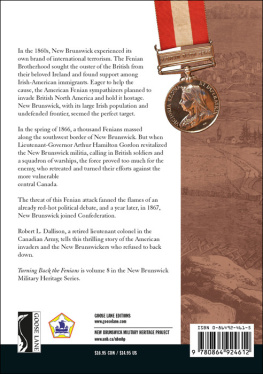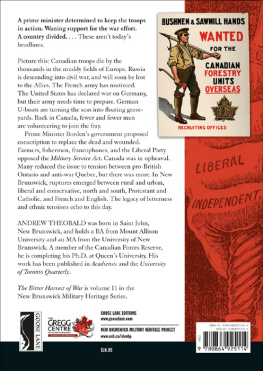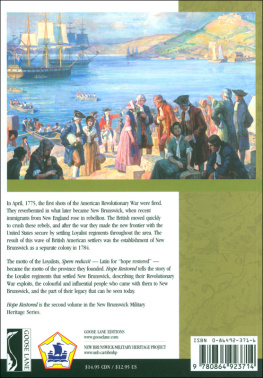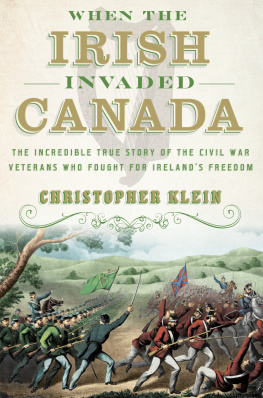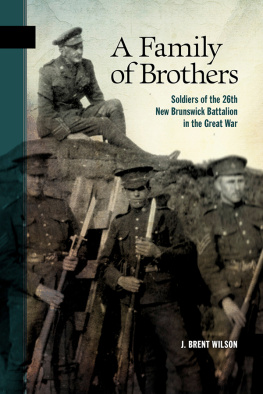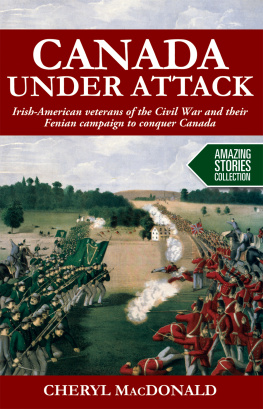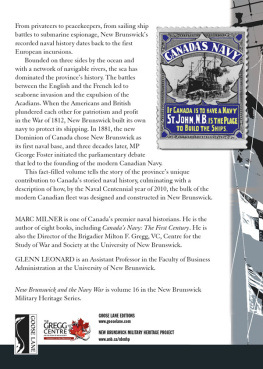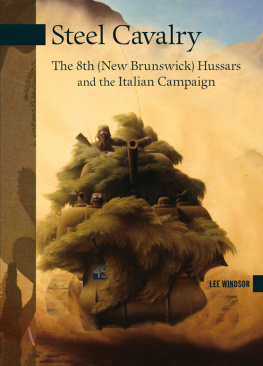Turning Back the Fenians
New Brunswicks Last Colonial Campaign
The New Brunswick Military Heritage Series, Volume 8
Turning Back the Fenians
NEW BRUNSWICKS LAST COLONIAL CAMPAIGN
Robert L. Dallison
Copyright Robert L. Dallison, 2006.
All rights reserved. No part of this work may be reproduced or used in any form or by any means, electronic or mechanical, including photocopying, recording, or any retrieval system, without the prior written permission of the publisher or a licence from the Canadian Copyright Licensing Agency (Access Copyright). To contact Access Copyright, visit www.accesscopyright.ca or call 1-800-893-5777.
Edited by Brent Wilson.
Cover illustration detailed from PANB P5-712 showing New Brunswick Militia.
officers at the 1866 Camp of Instruction at Torryburn, NB.
Cover design by Lisa Rousseau.
Interior page design by Julie Scriver.
Printed in Canada.
10 9 8 7 6 5 4 3 2 1
Library and Archives Canada Cataloguing in Publication
Dallison, Robert L., 1935
Turning back the Fenians: New Brunswicks last colonial
campaign / Robert L. Dallison.
(New Brunswick military heritage series; v.8)
Co-published with New Brunswick Military Heritage Project.
Includes bibliographical references and index.
ISBN 0-86492-461-5
1. New Brunswick History 1784-1867. 2. Canada History Fenian Invasions, 1866-1870. I. New Brunswick Military Heritage Project II. Title. III. Series.
FC2471.9.F4D34 2006 971.5102 C2006-904336-1
Goose Lane Editions acknowledges the financial support of the Canada Council for the Arts, the Government of Canada through the Book Publishing Industry Development Program (BPIDP), and the New Brunswick Department of Wellness, Culture and Sport for its publishing activities.
Goose Lane Editions
Suite 330, 500 Beaverbrook Court
Fredericton, New Brunswick
CANADA E3B 4X5
www.gooselane.com
New Brunswick Military Heritage Project
The Brigadier Milton F. Gregg, VC,
Centre for the Study of War and Society
University of New Brunswick
PO Box 4400
Fredericton, New Brunswick
Canada E3B 5A3
www.unb.ca/nbmhp
Contents
Chapter One
The Fenian Brotherhood
Chapter Two
Double Agents, Loose Lips and Rampant Rumour
Chapter Three
The Volunteer Militia
Chapter Four
Preparing a Welcome for the Fenians
Chapter Five
The St. Patrick Days Alert
Chapter Six
Let Them Come If They Dare
Chapter Seven
The Fenians Are Among Us
Chapter Eight
Imperial Military Might
Chapter Nine
The Turning Point
Chapter Ten
The Legacy
To Sharon, my wife and partner of half a century, whose love, support, and encouragement make life worthwhile.
No. 1 Company (Havelock Rifles) of the Saint John Volunteer Battalion, circa 1866-1867. The Havelock Rifles was one of the first volunteer militia companies formed in New Brunswick. NBM 1961-67
Introduction
New Brunswicks Indian Island lies uninhabited off the southeast corner of Deer Island, little noticed among the many beautiful islands in Passamaquoddy Bay. Today there is nothing to indicate that this small island was once an important trading depot on the border shared by New Brunswick and Maine and the scene of an international incident.
In 1866, Indian Island boasted a permanent resident population, a school, bonded warehouses and a customs house proudly flying the Union Jack, a flag that symbolized Great Britain and its worldwide empire. On Saturday, April 14, 1866, James Dixon, the customs officer on Indian Island, retired to bed after an exhausting and trying day caring for his ailing wife. Shortly after midnight, a violent knocking at the door and the ripping of shutters from their windows rudely awakened the Dixon family. Rushing to the door, Dixon was confronted by a body of armed men. Brandishing revolvers and threatening death to him and his family, they demanded Dixon hand over the British flag that flew over the customs house. Although he was reluctant to comply, the pleading of his frightened wife, who was concerned for the safety of their family, prompted Dixon to surrender his beloved Union Jack. Once back in Maine, the raiders jubilantly claimed a major victory. They triumphantly sent the flag to New York, where it was flaunted as a trophy of war. The American press made much of the fact that the British flag had been captured under the supposedly watchful eye of the Royal Navy, proclaiming that the incident will cause the British lion to shake his sides and lash his tail. Let him! The spirit of liberty is abroad.

Earliest known photograph of Indian Island dated prior to 1900. Campobello Island is in the background, left centre is Cherry Island, and Marble Island is to the right. The white house in the centre is the Moses residence. PANB P8-298
The armed band that terrorized the Dixon family were members of the Fenian Brotherhood, a revolutionary movement organized in Ireland with the goal of establishing an independent Irish Republic by armed force. It found support among the many Irish immigrants in the United States. To assist their Irish brothers in freeing Ireland, the Fenians conceived of a plan to invade British North America, with the goal of holding it hostage. With its large Irish population and undefended borders, New Brunswick appeared to be an ideal target, and a group of Fenians plotted to seize Campobello Island.
When the Fenians gathered along the Maine border in the spring of 1866, the people of New Brunswick felt vulnerable and feared for their safety. Mysterious and inexplicable Fenian activities, incursions, alarms and alerts increased the tension. Thanks to the leadership displayed by an energetic lieutenant-governor, effective defensive measures were eventually taken by the New Brunswick militia. Support from Great Britain followed, with British soldiers and a squadron of warships dispatched to the Bay of Fundy. By May 1866, the Fenians in Maine, recognizing that New Brunswick was no longer an easy target, dispersed and turned their focus on central Canada.
Although the Fenian crisis is now largely forgotten, it has left an enduring legacy, both militarily and politically. As the crisis unfolded, a number of concurrent themes emerged. First, in 1860, the New Brunswick militia was disorganized and in no state to contribute to the defence of the province. The initial task facing the commander-in-chief was to develop an effective local militia. By the end of the Fenian affair, local military forces had turned out in large numbers and helped to turn back this threat. Second, with the outbreak of the American Civil War, the relationship between the province of New Brunswick and its neighbours in the United States had rapidly deteriorated. With the arrival of the Fenians along the frontier, the reaction of the people of Maine would be decisive in shaping the outcome of the crisis. Third, with a large proportion of New Brunswicks population being Irish or of Irish descent, provincial authorities were concerned over their response to the Fenian cause. Would it reignite the bitter sectarian conflict between Catholic and Protestant that had plagued the province in the 1840s? Finally, a backdrop to the Fenian crisis was the ongoing struggle for the confederation of the provinces of British North America. The Fenian attacks came at a time when the confederation debate in New Brunswick had intensified to red-hot levels, and it tipped the balance in favour of Confederation.
Next page
